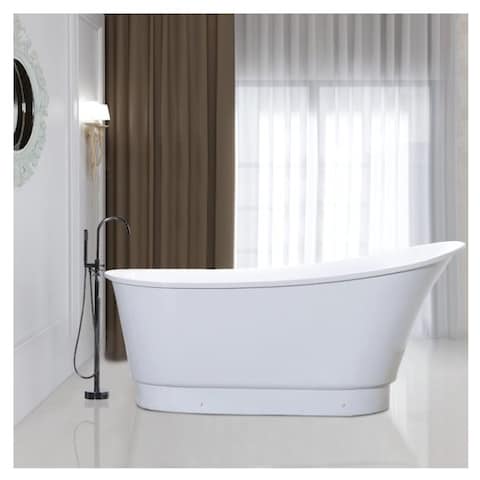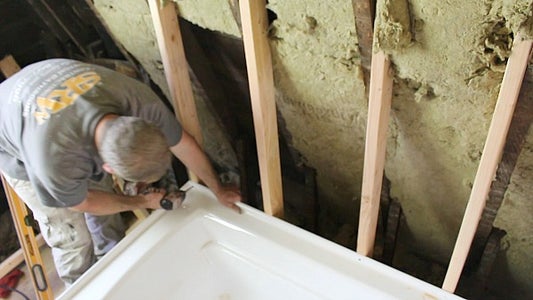Almost everyone maintains his or her own rationale with regards to Installing A Bathtub.

Setting up a bath tub isn't precisely brain surgery, yet it does need strong plumbing, carpentry, and also sometimes, tiling abilities. Changing an old tub with a brand-new one is also a moderately tough task. If the old tub is easily available, the task can move speedily; if you have to open up a wall to eliminate the old tub and place the new tub, the task is a lot harder. In either situation, the task is within a home handyman's abilities, although you will need an assistant to move out the old bathtub as well as set in the new one. Make certain you have actually qualified yourself for the work and fit trying it. Instead of working with a contractor to take control of a halfway-completed project, it is far better to consider utilizing one before you start. Chances are you might need an expert plumber to make tube links.
This short article will certainly help you install a brand-new bathtub in your shower room if you have currently purchased a brand-new tub as well as do not need to transform the setup of your previous water pipes.
Your devices and material checklist must consist of the following:
Getting ready for the Installment
Firstly, the supporting framework provided with the bathroom needs to be fitted (if required) according to the manufacturer's instructions. Next, fit the taps or mixer to the bathtub. When fitting the tap block, it is very important to make certain that if the faucet features a plastic washer, it is fitted between the bath and the taps. On a plastic bath, it is also reasonable to fit a sustaining plate under the faucets unit to prevent strain on the bathtub.
Fit the versatile tap ports to the bottom of the two taps utilizing 2 nuts as well as olives (often supplied with the tub). Fit the plug-hole outlet by smearing mastic filler round the sink outlet hole, and after that pass the outlet with the hole in the bath. Utilize the nut supplied by the producer to fit the plug-hole. Examine the plug-hole outlet for an inlet on the side for the overflow pipeline.
Next off, fit the end of the versatile overflow pipe to the overflow outlet. After that, screw the pipe to the overflow face which should be fitted inside the bath. Make sure you make use of every one of the provided washing machines.
Link the catch to the bottom of the waste electrical outlet on the bath tub by winding the string of the waste electrical outlet with silicone mastic or PTFE tape, as well as screw on the trap to the outlet. Connect all-time low of the overflow tube in a comparable manner.The bathroom must now be ready to be fitted in its final placement.
Removing Old Touches
If you need to replace old taps with brand-new ones as a part of your installment, after that the first thing you need to do is separate the water. After doing so, activate the faucets to drain any water remaining in the system. The process of removing the existing faucets can be fairly bothersome as a result of the limited gain access to that is typically the situation.
Use a basin wrench (crowsfoot spanner) or a faucet tool to undo the nut that connects the supply pipelines to the faucets. Have a fabric prepared for the remaining water that will originate from the pipelines. When the supply pipes have been eliminated, make use of the very same device to loosen up the nut that holds the taps onto the bath/basin. You will require to quit the single taps from transforming throughout this process. Once the taps have been eliminated, the holes in the bath/basin will need to be cleansed of any type of old sealing substance.
Prior to carrying on to fit the new faucets, contrast the pipeline links on the old taps to the brand-new faucets. If the old taps are longer than the new faucets, then a shank adapter is required for the brand-new taps to fit.
Installing the Bath tub
Utilizing the two wooden boards under its feet, position the tub in the required setting. The wooden boards are helpful in equally spreading the weight of the bathtub over the location of the boards instead of concentrating all the weight onto 4 small points.
The following objective is to ensure that the bath tub is leveled all round. This can be accomplished by examining the level and readjusting the feet on the bathtub till the spirit level reads degree.
To mount taps, fit all-time low of the furthest adaptable tap adapter to the suitable supply pipeline by making a compression join; after that do the same for the various other tap.
Activate the supply of water and inspect all joints and brand-new pipework for leaks as well as tighten them if necessary. Fill up the bathtub as well as likewise check the overflow electrical outlet and the normal electrical outlet for leaks.
Lastly, take care of the bath paneling as defined in the producer's user's manual. Tiling and securing around the bathtub ought to wait till the bathtub has actually been utilized at least once as this will certainly resolve it right into its final placement.
Fitting New Taps
If the tails of the brand-new taps are plastic, then you will require a plastic connector to stop damage to the thread. One end of the connector fits on the plastic tail of the faucet and also the other end supplies a link to the existent supply pipelines.
If you require to fit a monobloc, then you will call for decreasing couplers, which links the 10mm pipeline of the monobloc to the basic 15mm supply pipeline.
Next off, position the tap in the installing opening in the bath/basin ensuring that the washers are in location between the tap and also the sink. Safeguard the tap in place with the maker given backnut. When the tap is safely in position, the supply pipelines can be connected to the tails of the taps. The taps can either be connected by using corrugated copper piping or with typical faucet adapters. The former type ought to be linked to the faucet finishes initially, tightening only by hand. The supply pipes can later be connected to the other end. Tighten both ends with a spanner after both ends have actually been attached.
Tiling Around the Bath tub
In the location where the bath meets the tile, it is required to secure the accompanies a silicone rubber caulking. This is necessary as the installation can relocate sufficient to fracture an inflexible seal, causing the water to penetrate the wall between the bath and the tiling, resulting in issues with moisture as well as feasible leaks to the ceiling listed below.
You can select from a range of coloured sealants to blend in your fixtures and fittings. They are sold in tubes and cartridges, and are capable of sealing voids approximately a size of 3mm (1/8 inch). If you have a larger space to fill up, you can fill it with twists of soaked newspaper or soft rope. Remember to constantly load the bath tub with water prior to securing, to enable the movement experienced when the bathtub remains in usage. The sealant can crack rather very early if you do not think about this activity prior to securing.
Additionally, ceramic coving or quadrant tiles can be made use of to border the bath or shower tray. Plastic strips of coving, which are easy to use and reduce to dimension, are also conveniently readily available on the marketplace. It is a good idea to fit the ceramic tiles using water-resistant or water-proof sticky and grout.
Bathtub Installation
How Important Is A Bathtub To Your Home?
High-quality baths, showers, and other bathroom updates are necessary when considering a smart investment in your home. It’s a room that you go to every day and one that is constantly being used by guests.The bathroom is one of the top trafficked rooms in a home and also one of the most valuable in terms of home resale.
Install Piping Before Tub
You will be using your existing drain and waste vent system, but pipes required include the hot and cold water supply lines and a pipe leading to a shower head. A mixing valve and shower head are also needed. Air chambers may be required.
Position the Tub
Lower the tub into place so that the continuous flange fits against the wall studs and rests on 1’x4' or 2’x4' supports. Anchor the tub to the enclosure with nails or screws inserted through the flanges into the studs.
NOTE: Remember, bathtubs and shower stalls may require support framing. A bathtub filled with water is extremely heavy, so check building codes and framing support before installing the tub.
Assemble Drain Connections
Assemble the bathtub drain connections by connecting the tub overflow with the tub drain above the trap, not beyond it. The trap will have a compression fitting that screws over the arm of the overflow assembly.
Place a Pipe For the Shower Head
First, locate a brass female threaded winged fitting and attach it to a framing support via a screw or a nail. Then run a pipe up the wall for the shower head. Sweat or solder the other side of the brass fitting to the top of the pipe.
Attaching Hot and Cold Water Lines
Attach your water lines for both hot and cold by sweating these directly into the hot and cold ports of the mixing valve. The mixing valve will be how water enters the tub’s system, not by the pipes themselves.
Install the Spout
Extend a piece of 1/2 inch pipe, or whichever length is specified in the manufacturer’s instructions, for the tub spout. Sweat on a male threaded fitting at the end of the pipe or use a brass nipple of the proper length and a 1/2 inch cap.
NOTE: At this point you should have your rough-in plumbing work inspected before proceeding further.
Check For Leaks
Restore the water pressure and check the drain connection and the supply pipes for any sign of leaking.
estore the Bathroom Wall
Replace the wall with moisture-resistant drywall as a base for your wall covering. Seal the joints between the wall and your new tub with silicone caulk as protection against water seepage.
https://www.berkeys.com/2016/12/02/bathtub-installation-dallas/

We had been made aware of that write-up on How to Install a Bathtub Yourself through a good friend on another website. You should take a moment to distribute this entry if you enjoyed it. Kudos for your time. Come back soon.
Schedule Appointment Now